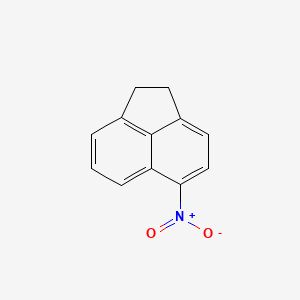D0753 | 5-nitroacenaphthene
| Toxicity | Dose | Time | Species | Model | Method | Action | Positive criterion | Reference |
|---|---|---|---|---|---|---|---|---|
| MEMBRANE POTENTIAL | 34.38±20.44 | human | qHTS-HepG2 | MMP assay | decrease | IC50 | 163 | |
| MEMBRANE POTENTIAL | 56.23 | human | HepG2 | MMP assay | decrease | IC50 | 163 | |
| MEMBRANE POTENTIAL | 24.04±16.19 | rat | hepatocytes | MMP assay | decrease | IC50 | 163 | |
| Pictogram | Signal | Statements | Precautionary Statement Codes |
|---|---|---|---|
 |
Danger |
H350: May cause cancer [Danger Carcinogenicity] |
P201, P202, P281, P308+P313, P405, and P501; (The corresponding statement to each P-code can be found at the GHS Classification page.) |
 |
Danger |
Aggregated GHS information provided by 42 companies from 1 notifications to the ECHA C&L Inventory. H350 (100%): May cause cancer [Danger Carcinogenicity] Information may vary between notifications depending on impurities, additives, and other factors. The percentage value in parenthesis indicates the notified classification ratio from companies that provide hazard codes. Only hazard codes with percentage values above 10% are shown. |
P201, P202, P281, P308+P313, P405, and P501; (The corresponding statement to each P-code can be found at the GHS Classification page.) |
 |
Danger |
H350: May cause cancer [Danger Carcinogenicity] |
P201, P202, P281, P308+P313, P405, and P501; (The corresponding statement to each P-code can be found at the GHS Classification page.) |
 |
Warning |
H351: Suspected of causing cancer [Warning Carcinogenicity] H373: Causes damage to organs through prolonged or repeated exposure [Warning Specific target organ toxicity, repeated exposure] |
P201, P202, P260, P281, P308+P313, P314, P405, and P501; (The corresponding statement to each P-code can be found at the GHS Classification page.) |
 |
Warning |
H351: Suspected of causing cancer [Warning Carcinogenicity] H373: Causes damage to organs through prolonged or repeated exposure [Warning Specific target organ toxicity, repeated exposure] |
P201, P202, P260, P281, P308+P313, P314, P405, and P501; (The corresponding statement to each P-code can be found at the GHS Classification page.) |
| 1,2-Dihydro-5-nitro-acenaphthylene | 1,2-Dihydro-5-nitroacenaphthylene | 4-05-00-01840 (Beilstein Handbook Reference) |
| 5-:nitroacenaphthene | 5-NITROACENAPHTHENE | 5-Nan |
| 5-Nitro-1,2-dihydroacenaphthylene | 5-Nitro-1,2-dihydroacenaphthylene # | 5-Nitro-acenaphthene |
| 5-Nitroacenaphthene(contains3-Nitroacenaphthene) | 5-Nitroacenaphthene, 85% | 5-Nitroacenaphthene, 85% (Assay) |
| 5-Nitroacenapthene | 5-Nitronaphthalene | 5-Nitronaphthalene ethylene |
| 602-87-9 | A832670 | AC-4959 |
| ACMC-209sgj | AKOS000121350 | ANW-41153 |
| Acenaphthene, 5-nitro- | Acenaphthylene, 1,2-dihydro-5-nitro- | Acenaphthylene,1,2-dihydro-5-nitro- |
| Acenaphthylene,2-dihydro-5-nitro- | BBL034664 | BRN 1876864 |
| C-51730 | C19269 | CAS-602-87-9 |
| CCRIS 438 | CHEBI:82350 | CHEMBL423081 |
| CTK5B1248 | CUARLQDWYSRQDF-UHFFFAOYSA-N | DB-050495 |
| DSSTox_CID_960 | DSSTox_GSID_20960 | DSSTox_RID_75888 |
| DTXSID3020960 | EINECS 210-025-0 | F023F6C79X |
| FT-0620701 | HSDB 4092 | J-517853 |
| KS-000016IG | LS-1436 | MCULE-8952865434 |
| MFCD00014277 | N0105 | NCGC00091685-01 |
| NCGC00091685-02 | NCGC00256570-01 | NCI-C01967 |
| NSC 1312 | NSC 22421 | NSC-1312 |
| NSC-22421 | NSC1312 | NSC22421 |
| OR7752 | Q27155891; | SBB067227 |
| SC-46897 | SCHEMBL267240 | ST24024161 |
| ST50826626 | STL428868 | TR-020837 |
| TRA0053422 | Tox21_302877 | UNII-F023F6C79X |
| VS-12631 | VZ30518 | W7281 |
| WLN: L566 1A LT&&J HNW | ZINC977211 | ZLC0432 |
| ZX-AT006715 | zlchem 567 |

